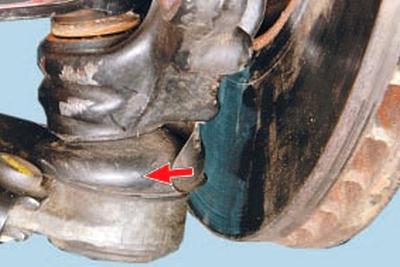During each maintenance and repair, it is imperative to check the condition of the protective covers of the ball bearings of the suspension, the covers must not be mechanically damaged.
Find out if there are any cracks on the suspension parts or traces of rubbing against road obstacles or the body, deformation of the levers, the stabilizer bar and its struts, the body front parts in the places where the suspension units and suspension parts are attached.
Check the condition of the rubber-metal joints, rubber pads, ball joints of the suspension, as well as the condition (draft) upper supports of telescopic suspension struts.
Rubber-metal hinges and rubber pads must be replaced in case of ruptures and one-sided buckling of rubber, as well as when cutting their end surfaces.
Carry out all checks and work from below the vehicle mounted on a lift or inspection ditch (with hanging front wheels).
During each maintenance and repair, it is imperative to check the condition of the protective covers of the ball bearings of the suspension, the covers must not be mechanically damaged.
Find out if there are any cracks on the suspension parts or traces of rubbing against road obstacles or the body, deformation of the levers, the stabilizer bar and its struts, the body front parts in the places where the suspension units and suspension parts are attached.
Check the condition of the rubber-metal joints, rubber pads, ball joints of the suspension, as well as the condition (draft) upper supports of telescopic suspension struts.
Rubber-metal hinges and rubber pads must be replaced in case of ruptures and one-sided buckling of rubber, as well as when cutting their end surfaces.
On the rubber parts of the suspension are not allowed: - signs of rubber aging; - mechanical damage.
On rubber-metal hinges, the following is not allowed: - signs of aging, cracks, one-sided bulging of the rubber mass; - separation of the rubber mass from the reinforcement.
Replace defective parts.
WARNING: Pay special attention to mechanical damage (deformations, cracks, etc.) suspension components, especially control arms.

1. Check up a condition of protective covers of spherical support. If the boots are damaged, replace the ball joint assemblies.
2. Shaking the wheel in a vertical plane, check the ball joints for play. If there is play in the ball pins, replace the bearings.
USEFUL ADVICE: When shaking the front wheel, it is difficult to distinguish play in the hub bearings and in the ball bearings. Ask an assistant to press the brake pedal: if in this case you feel play, then the ball bearings are faulty.

3. Check the front silent block and rubber bush for play at the points where the levers are attached to the suspension subframe using a mounting spatula.

4. Check up a condition of racks and rubber pillows of the antiroll bar, rocking a bar of the stabilizer up and down.

5. Check up a condition of a protective casing of a shock-absorber rack.
6. Raise the protective cover and check the shock absorber for tightness. Fluid leaks are not allowed.
7. Replace defective or damaged parts.
suspension hoists are not allowed: – signs of rubber aging; - mechanical damage.
On rubber-metal hinges, the following is not allowed: - signs of aging, cracks, one-sided bulging of the rubber mass; - separation of the rubber mass from the reinforcement.
Replace defective parts.
WARNING: Pay special attention to mechanical damage (deformations, cracks, etc.) suspension components, especially control arms.
1. Check up a condition of protective covers of spherical support. If the boots are damaged, replace the ball joint assemblies.
2. Shaking the wheel in a vertical plane, check the ball joints for play. If there is play in the ball pins, replace the bearings.
USEFUL ADVICE: When shaking the front wheel, it is difficult to distinguish play in the hub bearings and in the ball bearings. Ask an assistant to press the brake pedal: if in this case you feel play, then the ball bearings are faulty.
3. Check the front silent block and rubber bush for play at the points where the levers are attached to the suspension subframe using a mounting spatula.
4. Check up a condition of racks and rubber pillows of the antiroll bar, rocking a bar of the stabilizer up and down.
5. Check up a condition of a protective casing of a shock-absorber rack.
6. Raise the protective cover and check the shock absorber for tightness. Fluid leaks are not allowed.
7. Replace defective or damaged parts.
Visitor comments